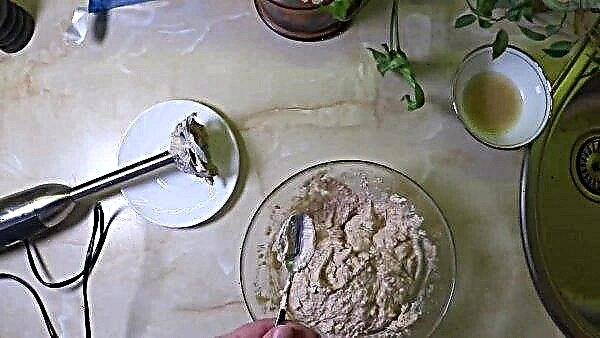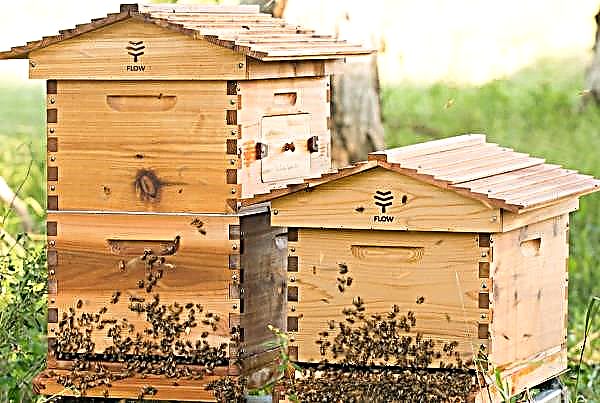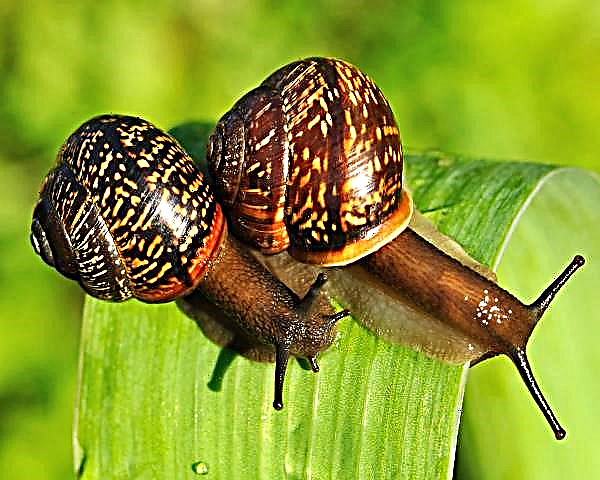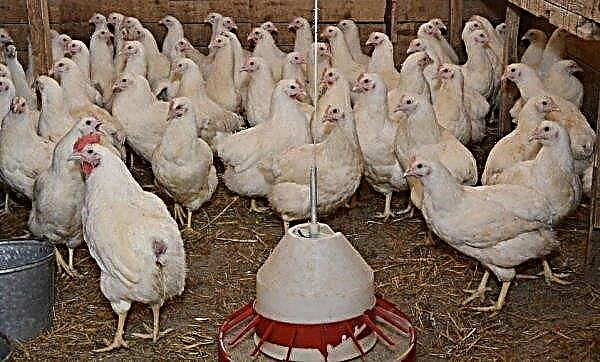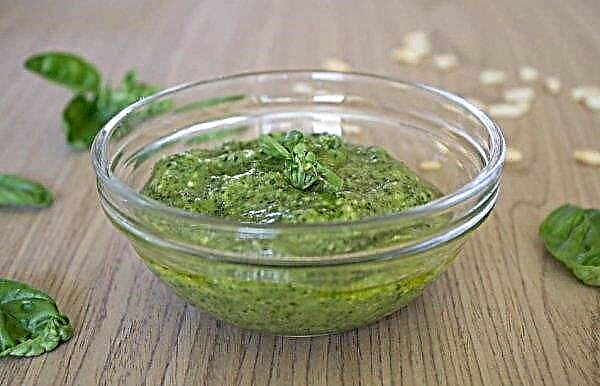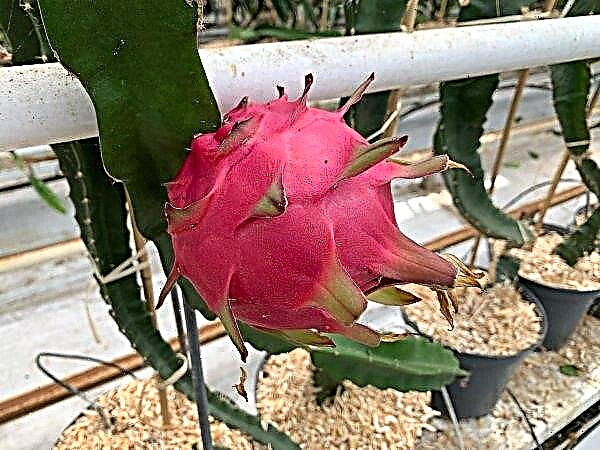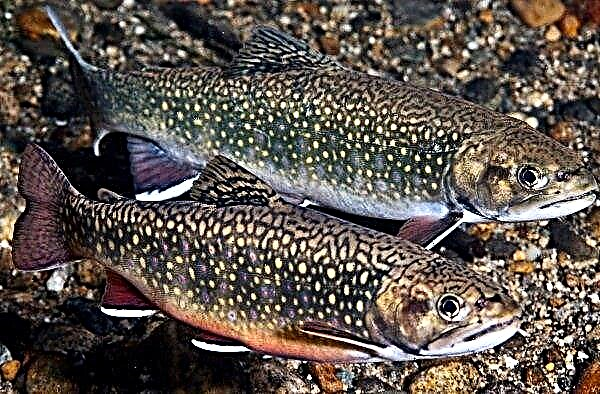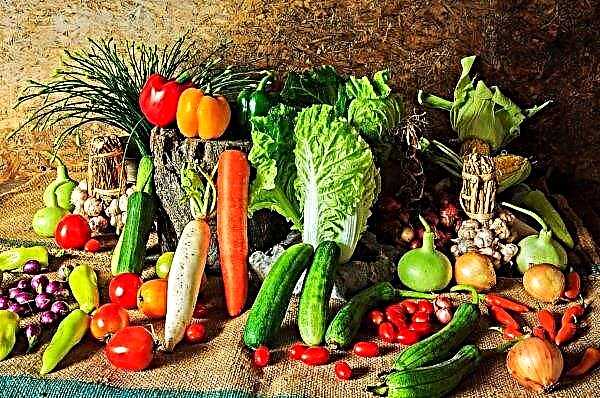It is impossible to imagine a garden without a potato plant growing on it. This vegetable is one of the most sought after and loved in the human diet. There are about 5 thousand varieties of culture: with different ripening dates, taste palette and external data. When choosing planting material for early-ripening products, be sure to pay attention to the Alena variety. Possessing unpretentiousness in cultivation and a large set of positive aspects, he won the favor of not only amateur gardeners, but also professionals.
Description and characteristic
Alena is an early ripe variety - from the emergence of seedlings to the harvest of potatoes takes 45-60 days. This variety has the following individual parameters:the bush is short, sprawling; the leaves are dark green with a slightly wavy edge; the flowers are pink with a purple tint, collected at the top of the shoot; the stem is “bare”, ribbed, partially buried in the soil; the tubers are oval with a mass of 150 -200 g; the root peel is smooth, thin, pink-red; the vegetable flesh is white with a creamy tint. The Alena variety appeared thanks to the breeders of the Siberian Research Institute of Agriculture (Omsk Agrarian Scientific Center). For selection, varieties Sedov, Kameraz and Zarevo were used. The resulting variety of potatoes was patented in the State Register of Seed Production of the Russian Federation in 2000.
Taste qualities
Vegetable has excellent taste characteristics, which are determined by the presence of appropriate chemical compounds and their concentration. The list of substances that determine the taste of potatoes is quite large.
The main ones are:water - 75%; starch - 17%; nitrogenous substances (crude protein) - 2%; sugar - 1.5%; fiber - 1%. Thanks to such a successful selection of useful components and the presence of this amount of starch, the variety is moderately boiled (medium - crumbly) and is widely used in cooking: it is boiled, stewed, baked, fried, used in both simple and gourmet dishes. The variety is particularly suitable for the industrial manufacture of chips.
Did you know? In ancient times, in the Solomon Islands, potatoes were used as the equivalent of money - a visit to the doctor cost one potato.
Ripening period
The period of full vegetative ripening of a vegetable depends on the region of growth and weather conditions. This variety tolerates both arid and colder climates. The ripening time of the crop is, on average, from 45 to 65 days.
Productivity
To obtain early production, tubers are harvested on the 45-50th day of vegetation; yield, at the same time, is 150 c / ha. Commodity yield, after full ripening of the vegetable (60–65 days), about 172–290 c / ha. The maximum yield of the variety in the Omsk region - 391 kg / ha, is a record indicator of Alena.
Disease resistance
The described potato plant has average resistance to infectious and viral diseases. Alena has good resistance to such diseases as: common scab, rhizoctoniosis, potato cancer. Susceptible to late blight, a golden cyst-forming nematode.
Alyona tubers are a sample product with a set of undeniably positive qualities. Unfortunately, there are some negative aspects inherent in this vegetable. Let's consider features in more detail.Did you know? Early potatoes contain 3 times more vitamins and nutrients than other, later varieties of this vegetable.
Advantages and disadvantages of the variety
The plant stands out among other potato species by the presence of a large stock of positive characteristics.
- The benefits are as follows:
- high, stable productivity;
- early, friendly ripening of tubers;
- excellent adaptation to growing conditions;
- good resistance to drought;
- excellent taste;
- long-term storage (7-8 months);
- excellent presentation;
- Suitability for mechanized cultivation technology.
- Unfortunately, there is a negative point:
- susceptibility to late blight and golden nematode.
Like any other garden crop, potatoes need the correct, competent application of agrotechnical measures.
Planting and growing varieties
The technology for growing early potatoes is not complicated and does not require the use of any special costs and efforts. But in order to get a tasty and healthy crop, you need to pay attention to the plant and proper care.
The timing
The time of planting of seed material depends on the locality of growth of this plant:
- in the southern regions - April first decade;
- in the western and eastern territories - the end of April - the beginning of May;
- for the northern regions - the second half of the May period.
 Soil, by this time, should warm up to +4 ... + 8 ° С. It is important to note that potatoes do not tolerate frost. When the ambient temperature drops to -0.5 ° C or lower, the aboveground part of the plant dies. The newly overgrown shoots form a weak, underdeveloped plant - yield decreases almost by half.
Soil, by this time, should warm up to +4 ... + 8 ° С. It is important to note that potatoes do not tolerate frost. When the ambient temperature drops to -0.5 ° C or lower, the aboveground part of the plant dies. The newly overgrown shoots form a weak, underdeveloped plant - yield decreases almost by half.Crop rotation rules
The use of rational crop rotation is the key to obtaining a good result when growing a potato product. Constant cultivation of a vegetable in one place leads to depletion of the soil, the accumulation of various infections and viruses in it. Therefore, the location of planting should be constantly changed.
Good precursors for potatoes are:
- legumes (peas, beans);
- roots;
- cabbage;
- cucumbers
- garlic;
- gourds.
 You can not plant a vegetable in the beds where they used to grow:
You can not plant a vegetable in the beds where they used to grow:- corn;
- sunflower;
- tomatoes and other members of the nightshade family.
Soil requirements
The landing site is bright and sunny, with a low level of groundwater. Potato grows well on chernozem, slightly acidic, peat soils; loamy or sandy loamy soils. The land is heavy, clay, and also sandy soil is not suitable for growing crops. Potato perfectly forms tubers if the soil is loose, moist enough, has good air access and water permeability.
Preparing tubers for planting
Potatoes for planting in the soil are sorted: the damaged ones are rejected, leaving the strongest and healthiest, of the same size (a little more than a chicken egg). A month before the intended planting, potato tubers begin to sprout. Such an event makes it possible to obtain early harvesting in a shorter time.
There are several variations of this method.
- In the light. Boxes with prepared seed potatoes are placed in a bright place without direct sunlight. Germination lasts 25-30 days. In the absence of natural light, backlighting is used - fluorescent lamps.
- In a wet substrate. Tubers are placed in wet sawdust or peat, making sure that the substrate does not dry out. Sprouts appear after 18-20 days.
- Withering. The easiest way to prepare seeds. Prepared tubers are laid out on the floor of the room (attic, barn, garage). Shoots form within 2 weeks.
- In packages. Transparent plastic bags with tubers are placed in places of diffused sunlight. They must be periodically deployed and turned over for uniform illumination. Package weight should be 1.5–2 kg. The shoots grow in 15-18 days.
Landing technology
Before starting planting potatoes, a preliminary marking of the site is carried out. Usually pegs and threads are used for this. The depth of the holes is determined by the state of the soil. The heavier the soil, the less deep the holes are made: for sandy, peaty soils - 8-10 cm, for loamy - 5-6 cm. Planting a vegetable in the ground can be done in several ways.
- In rows (under the shovel). The early vegetables are planted at a distance of 25 cm from each other, the distance between the rows is 0.7 m. Planted potatoes are sprinkled with earth from the hole of the next row. It is advisable to immediately apply fertilizer to each well: half a glass of wood ash with humus or one teaspoon of nitroamophos. At the end of planting, the land on the site is leveled with a rake.

- In the crests. Solid furrows are made with a shovel or walk-behind tractor with a depth of 15 cm. On the surface of the top of the ridge, holes will be made at a distance of 25 cm, where the tubers are laid. They fall asleep with soil from adjacent row spacing. The gap between the ridges is 70 cm.
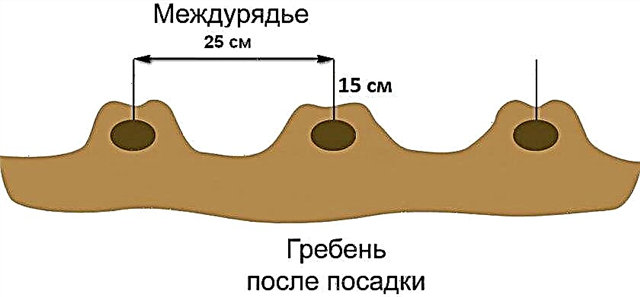
- In the trench. This method of planting is more often used for regions with a cold climate. "Warm" ridges are prepared in the fall. In done furrows, to a depth of 30 cm, organic matter is laid. In the spring, after sedimentation of fertilizers, potatoes are planted in trenches and covered with earth. Landing pattern is the same as in previous versions.

- In double rows. Two adjacent rows are located at a distance of 0.3 m with a row spacing of 1.1 m.

- The planting of tubers occurs in staggered, with an interval of 35 cm. Spud in one row.
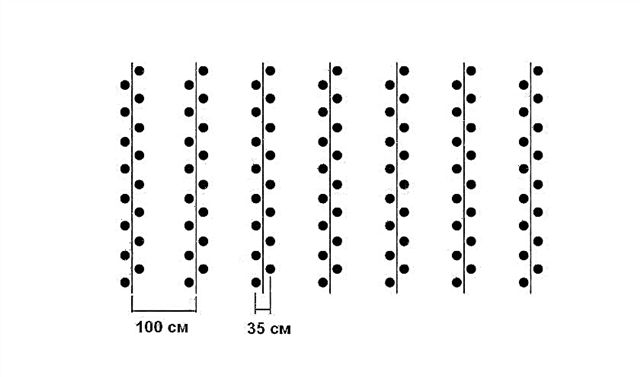
Care Features
After the emergence of seedlings, it is necessary to carry out a number of measures aimed at a comfortable and rapid growth of plants, in order to obtain high yield.
Fertilizer
Correct and timely feeding of plantations is one of the best ways to increase crop productivity.
Important! For better assimilation of nutrients, it is recommended that the application of root (under the root) fertilizers only in pre-moistened soil.
Carry out these works in several stages:
- after germination - 1 kg of chicken manure is diluted in 15 liters of water (insist 48 hours), a liter of the resulting solution is poured under the root;
- before hilling - 1 tbsp. a spoon of urea is dissolved in 10 liters of water, contribute 0.5 l of the substance under the bush;
- during budding - in ten liters of water stir 3 tbsp. tablespoons of superphosphate and irrigate the bushes;
- during flowering - per bucket of water: 100 g superphosphate, 0.5 kg mullein. Mix and pour 0.5 l of the obtained substance under each plant.
Video: how to fertilize potatoes
Watering
Alena's potatoes tolerate sultry time well, but still gratefully respond to generous watering. Adequate moisture in the earth will help tubers to fully grow green mass and form a larger number of "children." Lack of moisture will lead to depletion of the plant, reducing its potential.
Therefore, it is advisable, in the absence of rainfall, to water the plantations twice a week:
- after emergence - for the normal development of the aerial parts;
- during flowering - with the formation of tubers, their number increases;
- after flowering is complete, in order to activate the mass gain of tubers.
 Watering is carried out in the evening, after a decline in heat with the use of a large volume of water. The soil layer should be moistened to a depth of at least 10 cm for proper nutrition of the plant.
Watering is carried out in the evening, after a decline in heat with the use of a large volume of water. The soil layer should be moistened to a depth of at least 10 cm for proper nutrition of the plant.Weeding and hilling
A week after planting, the first weeding is carried out between the rows, and then, as the weeds grow, every 7 days. Sprinkling the plant stems with moist earth and loosening occurs simultaneously. Hilling is carried out 2 times during the growing season. The first powdering is done when the sprouts reach a height of 8-10 cm, after two weeks the procedure is repeated. At each event, soil 5–12 cm high is added to each bush.
Hilling potatoes offers the following benefits:
- increases productivity by 25-30%;
- reduces lodging of stems;
- increases the formation of additional nodules;
- promotes good air circulation in the underground part of the plant;
- retains moisture and nutrients;
- does not allow the appearance of "green" potatoes.
Important! It is impossible to carry out the earthing up during the flowering of plants, since during this period there is an increased growth of the underground part of the nightshade culture, there is a risk of damage.
Prevention of diseases and pests of the variety
Potato plants are susceptible to certain viral and infectious diseases, and suffer from pests. It is necessary to take timely and preventive measures to prevent the death of the plant and to fully preserve the future crop.
Alena is susceptible to some negative phenomena.
- Late blight. One of the most common fungal diseases of the culture that affects the entire plant. Dark brown spots that appear first on the leaves, gradually turn to tubers. Used for treatment and prevention: copper sulfate, Bordeaux liquid, drugs "Ridomil", "Agate", "Shirpan".
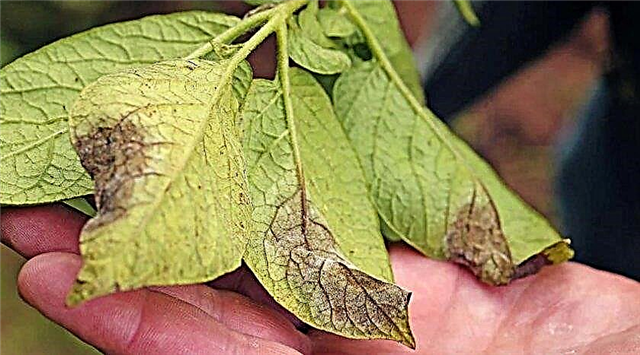
- Common scab. A fungal disease that most often affects red-skinned tubers. Small ulcers, scabs form on the fruits, which grow over time. To combat the disease used "Prestige", "Ditan", "Acrobat MC", "Ordan".
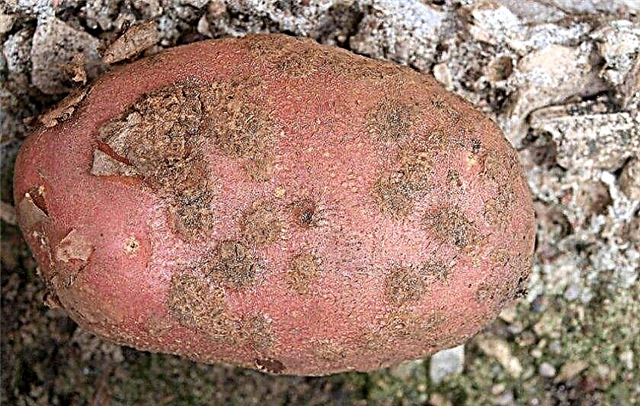
Consider the most dangerous of them.
- Colorado beetle. This insect is one of the most dangerous pests of potatoes. If you do not take measures to destroy it, then the death of the entire crop is likely. In the confrontation with the parasite, the following are used: insecticides "Aktara", "Bombardir", "Commander", "Golden Spark", etc.

- Golden nematode. A small parasite worm (up to 1 mm long) living on a plant and affecting it whole. Nematicides, as well as Nemabakt, Karbofos, are well suited for controlling the parasite.

- Bear A malicious pest living in the ground and eating not only the plants themselves, but also tubers. Insectoacaricides - Terradox, Wofatox, Medvecid, and Rembek biological product are effective in controlling insects.
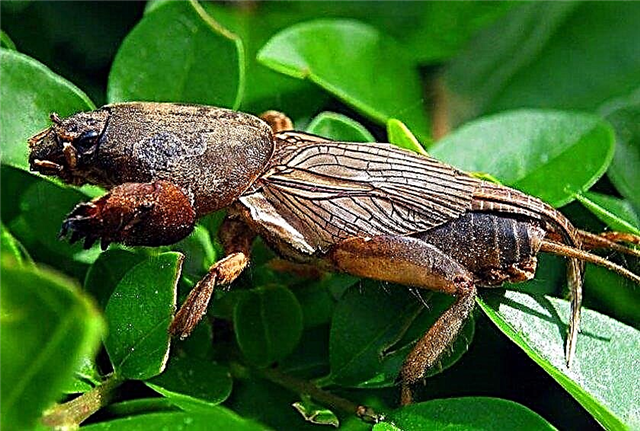
For these purposes, it is necessary to carry out the following operations:
- comply with crop rotation rules;
- to disinfect planting material, agricultural implements and premises for storing vegetable products;
- remove diseased plants from the beds;
- timely use of chemicals and folk remedies for plant protection.
Harvesting and storage
It is possible to determine that the potato has ripened by the autumn withering of the aerial part. 2 days before the expected collection of the product, the tops are mowed or cut. Tubers are harvested in dry, clear weather. Using a pitchfork or a shovel, carefully dig a bush from the side of the ridge, shake the ground and leave the tubers to dry for 2-3 hours.Before laying for storage, the vegetable is sorted, removing damaged and diseased specimens. The crop is placed in a dry, well-ventilated room with a temperature regime of +2 ... + 4 ° C and a relative humidity of 80% - 90%.
Vegetables can be kept in storage, using one of the options:
- in boxes - tubers are placed in containers that are placed on pallets or boards (distance from the floor - at least 10 cm);
- in bulk - the potato layer should not exceed 1.5 m;
- in nets, fabric bags - stacks, not more than 1.5 m high.
Alena's potatoes are unpretentious during cultivation - it does not require special expenses and efforts. In the presence of such small flaws that are lost against the backdrop of a huge number of positive criteria, this variety of solanaceous plant is undoubtedly worthy of taking an honorable place in your garden. Fulfilling the necessary recommendations for agricultural farming, taking care and proper care of the plant, you will certainly get the expected result: a high, excellent crop of your favorite vegetable.











